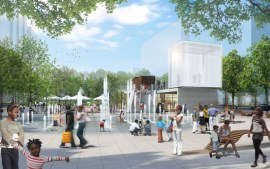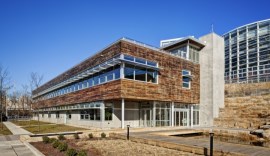by Shane Henson — December 16, 2013—The Sustainable Sites Initiative (SITES) program recently announced three new projects in urban settings that have achieved certification under the program’s comprehensive rating system for sustainable landscapes.
The SITES program is a collaboration of the American Society of Landscape Architects, the Lady Bird Johnson Wildflower Center of the University of Texas at Austin, and the United States Botanic Garden. According to the entities, the SITES program was created to fill a critical need for development guidelines and recognition of sustainable landscapes based on their planning, design, construction and intended maintenance. This voluntary, national rating system and set of performance benchmarks can be applied to projects on sites with or without buildings.
The program’s newly certified projects are Shoemaker Green, a university green space in Philadelphia, Pennsylvania, which received two stars; Washington Canal Park in Washington, DC, which received three stars; and Phipps’ Center for Sustainable Landscapes in Pittsburgh, Pennsylvania, which is the first SITES pilot project to have received the maximum rating of four stars.
The three newly certified projects showcase how even landscapes can be designed and constructed in a sustainable way:
Shoemaker Green, Andropogon Associates, Philadelphia, PA: As part of the University of Pennsylvania’s “Penn Connects” campus master plan, this deteriorating site with underused tennis courts was redesigned as a passive open space of lawns, tree-lined walkways, and sitting areas. The green space is both a destination and a pedestrian route from the core of campus to the historic buildings surrounding it. Through the innovative use of various sustainable strategies and technologies, Shoemaker Green has also been optimized to capture and control stormwater from the site and surrounding rooftops, provide viable native plant and animal habitats, minimize transportation of materials to and from the site, and serve as a starting point for the development of a sustainable maintenance strategy for the university at large.

Washington Canal Park, OLIN, Washington, DC: One of the first parks built as part of the District of Columbia’s Anacostia Waterfront Initiative, Canal Park is a model of sustainability, establishing itself as a social gathering place and an economic catalyst. Located on three acres of a former parking lot for district school buses, the three-block-long park is located along the historic former Washington Canal system, and is a centerpiece for approximately 10,000 office workers and about 2,000 new mixed market-rate and affordable housing units. Canal Park’s focal point, a linear rain garden, functions as an integrated stormwater system that is estimated to save the District of Columbia 1.5 million gallons of potable water per year. The park also features electric car charging stations and a neighborhood-scale system for capturing, treating, and reusing rainwater.

Phipps’ Center for Sustainable Landscapes Andropogon Associates, Pittsburgh, PA: The center was designed to be the first project in the world to simultaneously achieve LEED Platinum, SITES four-star certification, and The Living Building Challenge (still pending). Built on a previously paved city maintenance yard and documented brownfield, the nearly three-acre site supports a new 24,350-square-foot education, research, and administrative building; manages all sanitary waste and a 10-year storm event on site using a range of green infrastructure strategies; has successfully reintroduced 150 native plant species; and is designed to be net-zero for energy and water.
The new projects join 23 others across the country that have achieved certification since June 2010 as SITES pilot projects. These diverse projects represent landscapes of various sizes, locations, types and costs.




